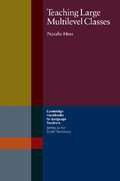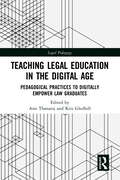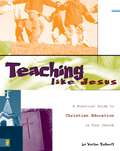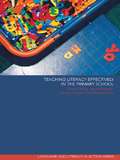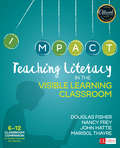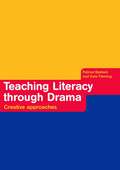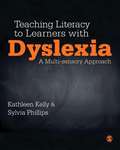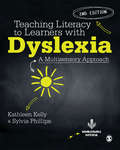- Table View
- List View
Teaching Large Classes in Higher Education: How to Maintain Quality with Reduced Resources
by Alan Jenkins Graham GibbsThis guide combines theory on teaching methodology with advice on good teaching practice in order to help teachers face the challenge of larger numbers of students in their classrooms. It includes a number of case studies which explore innovative teaching methods.
Teaching Large Multilevel Classes
by Penny Ur Natalie HessThis book provides practical advice for teachers who work with large, mixed-ability classes. It offers a wide variety of activities to develop student motivation, interest, participation and responsibility.
Teaching Late-Twentieth-Century Mexicana and Chicana Writers (Options for Teaching #53)
by Elizabeth Coonrod MartínezMexicana and Chicana authors from the late 1970s to the turn of the century helped overturn the patriarchal literary culture and mores of their time. This landmark volume acquaints readers with the provocative, at times defiant, yet subtle discourses of this important generation of writers and explains the influences and historical contexts that shaped their work.Until now, little criticism has been published about these important works. Addressing this oversight, Teaching Late-Twentieth-Century Mexicana and Chicana Writers starts with essays on Mexicana and Chicana authors. It then features essays on specific teaching strategies suitable for literature surveys and courses in cultural studies, Latino studies, interdisciplinary and comparative studies, humanities, and general education that aim to explore the intersectionalities represented in these works. Experienced teachers offer guidance on using these works to introduce students to border studies, transnational studies, sexuality studies, disability studies, contemporary Mexican history and Latino history in the United States, the history of social movements, and concepts of race and gender.
Teaching Law
by Robin L. WestTeaching Law reimagines law-school teaching and scholarship by going beyond crises now besetting the legal academy and examining deeper and longer-lasting challenges. The book argues that the legal academy has long neglected the needs to focus teaching and scholarship on the ideals of justice that law fitfully serves, the political origins of law, and the development of a respectful but critical relationship with the legal profession. This book suggests reforms to improve the quality of legal education and responds to concerns that law schools eschew the study of justice, rendering students amoralist; that law schools slight the political sources of law, particularly in legislative action; and that law schools have ignored the profession entirely. These areas of neglect have impoverished legal teaching and scholarship as the academy is refashioned in response to current financial exigencies, and addressing them is long overdue.
Teaching Leadership: An Integrative Approach (Leadership: Research and Practice)
by Barbara C. CrosbyTeaching Leadership provides guidance for leadership educators in a variety of organizational and community contexts and across academic disciplines. An experienced leadership educator, Crosby promotes an inclusive vision of leadership that recognizes the inherent leadership potential in everyone. Featuring interviews with 25 respected leadership educators, Teaching Leadership complicates and enriches the leader-follower dichotomy to advance a holistic and practice-oriented model of leadership education. Using the metaphor of ‘heart, head, and hands,’ Crosby shows how authentic leadership is an embodied practice based equally in emotional, intellectual, and experiential learning.
Teaching Learning and New Technologies in Higher Education
by N. V. Varghese Sayantan MandalThis book discusses emerging issues related to teaching-learning in Indian higher education and the integration of technology. It brings together a host of national and international experts specializing in various aspects of teaching-learning in higher education, technology, and classroom practices to present policy and organizational strategies for enhancing innovation in teaching-learning processes, and offers a comprehensive overview of teaching-learning in connection with broader themes and concerns such as academic freedom, globalization, and new technologies. Reviewing a wide range of current practices and discussing specific teaching-learning challenges in depth, the book will be of interest to researchers and students of education, practitioners of higher education policy, and teacher educators alike.
Teaching Legal Education in the Digital Age: Pedagogical Practices to Digitally Empower Law Graduates (Legal Pedagogy)
by Kris Gledhill Ann ThanarajTeaching Legal Education in the Digital Age explores how legal pedagogy and curriculum design should be modernised to ensure that law students have a realistic view of the future of the legal profession. Using future readiness and digital empowerment as central themes, chapters discuss the use of technology to enhance the design and delivery of the curriculum and argue the need for the curriculum to be developed to prepare students for the use of technology in the workplace. The volume draws together a range of contributions to consider the impact of digital pedagogies in legal education and propose how technology can be used in the law curriculum to enhance student learning in law schools and lead excellence in teaching. Throughout, the authors consider what it means to be future-ready and what we can do as law academics to facilitate the knowledge, skills and dispositions needed by future-ready graduates. Part of Routledge’s series on Legal Pedagogy, this book will be of great interest to academics, post-graduate students, teachers and researchers of evidence law, as well as those with a wider interest in legal pedagogy or legal practice.
Teaching Life Skills in the Liberal Arts and Sciences: Preparing Students for Success Beyond the Classroom
by Angela C. BauerToday’s students seek an education that connects classroom learning to their future success, both personal and professional. Teaching Life Skills in the Liberal Arts and Sciences: Preparing Students for Success Beyond the Classroom is a practical guide for faculty and academic leaders who wish to meet this need by intentionally teaching and assessing the skills that employers most value: critical thinking, teamwork, emotional intelligence, cultural competence, ethical reasoning, and coachability.Grounded in research from higher education and employer surveys, this book provides evidence-based strategies for teaching and assessing key life skills, while still honoring the traditions of the liberal arts. Chapters feature detailed guidance and creative prompts for using AI tools to further enhance instructional design. By connecting academic experiences with students’ long-term goals, this book reaffirms the enduring relevance of a liberal arts education and offers a sustainable path forward in a rapidly changing world.
Teaching Life: Our Calling, Our Choices, Our Challenges (Routledge Leading Change Series)
by Armand DoucetIn this engaging book, Armand Doucet, a globally respected and recognized teacher, provides a clear roadmap for championing classroom-focused change in a technology-advanced society. Teaching Life brings the voices of teachers into the global conversation about educational reform to offer a how-to for implementing into classrooms design thinking, technology integration and a holistic education based on competencies, social-emotional learning and the literacies. With the innovative ideas in this book, educators can create a foundation for sustainable, honest, transparent leadership and work toward building a true community of local and global learning.
Teaching Like Jesus: A Practical Guide to Christian Education in Your Church
by La Verne TolbertAs a teacher, you long to help others do more than understand the Bible. You want them to experience its relevance and power for their lives. Teaching like Jesus is the answer! This commonsense guide offers examples of Jesus' teaching style from the Gospels, then shows how you can make these principles work for you -- regardless of what age group or ethnic background you're dealing with. Using a proven, four-step plan, Teaching Like Jesus gives you action steps, summaries, and other practical resources that will make your classroom a lively place to learn and apply the lessons so vitally important for transforming lives and nurturing disciples. You'll learn to think in terms of "see, hear, and do" in your lesson plans. And you'll find sample plans for age groups and cultures ranging from African-American preschoolers to Chinese married couples.
Teaching Literacy Effectively in the Modern Classroom for Ages 5–8: A Practical Guide for Teaching Reading and Writing in Diverse Learning Environments
by Tom Nicholson Sue DymockDesigned as a “one stop shop” for classroom teachers, this book covers assessment, planning, and progression of writing, spelling, decoding, vocabulary, and comprehension to expand the teaching toolbox.Dymock and Nicholson explore major focus areas in literacy instruction for teachers based on data-driven research advances. They provide the teacher a handy reference manual to consult when designing lessons to teach young children from diverse backgrounds to help them read and write for success. A general discussion of the research literature is built into the structure of the book to give teachers a knowledge base to teach and explain to children the why and the how of what they are learning. The chapters cover recent concepts of structured literacy, including systematic teaching of decoding skills, vocabulary, comprehension, writing, and spelling. This practical guide uses a scope and sequence approach to teaching that gives children a solid foundation of reading and writing skills. The resources and lesson ideas will engage diverse groups in a classroom, including those at risk of literacy difficulties such as dyslexia, so they also can achieve typical achievement levels for their age – and beyond. Containing a wealth of resources and tips for teaching children ages 5–8, alongside easily downloadable lesson plans, hand-drawn charts, and posters, this book will be of great interest to all classroom teachers involved in teaching literacy.This resource-filled book will appeal to teachers, professionals, and researchers in teacher training, with a focus on the needs of the teacher, providing practical and insightful ways to teach effectively in diverse classroom settings.
Teaching Literacy Effectively in the Primary School (Language and Literacy in Action)
by Jane Medwell David Wray Louise Poulson Richard FoxThis book discusses the implications arising from the authors' research into what constitutes an effective teacher of literacy. They have been able to identify what effective teachers know, understand and do which enable them to put effective teaching of literacy into practice in the primary phase. By identifying the strategies used by these teachers, the authors show how these can be applied by other primary teachers to improve their teaching of literacy.
Teaching Literacy in Early and Middle Childhood
by Karen Loman Angela Danley Natalie TyeTeaching Literacy in Early and Middle Childhood provides pre-service and practicing teachers with effective strategies for teaching English Language Arts. Filled with suggestions that can immediately be put to use, the anthology focuses on supporting the successful implementation of English Language Arts standards. Featuring topics such as vocabulary instruction, teaching phonemic awareness, fostering comprehension, and the use of graphic organizers and visual strategies, each chapter of the book gives the reader a deeper understanding of specific literacy content. The readings are framed by original introductions and learning activities that support content comprehension. Readers who follow the suggested before, during, and after reading activities will benefit from complete immersion into the material. The second edition features updated chapter introductions and seven new readings that explore phonics and mediated word identification, various approaches to teaching reading comprehension, the benefits of assisted reading, building English language learners' academic vocabulary, and more. Teaching Literacy in Early and Middle Childhood combines practical and theoretically sound instruction strategies for literacy with learning activities for educators. Designed as a supplement for standard textbooks, the anthology is well-suited to courses in K-6 education, English instruction, and reading.
Teaching Literacy in Troubled Times: Identity, Inquiry, and Social Action at the Heart of Instruction (Corwin Literacy)
by Peter Smagorinsky Allison Skerrett"Upending deficit narrative of learning loss, combating broken approaches to racial equity, and wading deep into the contested waters of democratic principles of learning within today’s schools, Dr. Skerrett and Dr. Smagorinsky offer an accessible guidebook for making our classrooms sites of justice and joy. Perhaps most importantly, theirs is a book that reveals classroom practices as they really are--the voices of teachers are situated as co-authors in this important journey. I cannot think of a more timely or relevant book for English educators than Teaching Literacy in Troubled Times." — Antero Garcia, Ph.D., Associate Professor, Graduate School of Education, Stanford University Relevant instruction to move education forward instead of "back to normal" Educators often bemoan the so-called learning gap that followed the upheaval to schooling in 2020, but the real learning gap will occur if the watershed events and social shifts of the early 2020s are not integrated into school instruction and learning. For today’s learning to be relevant to today’s students, it must reflect their lives and the true social worlds they inhabit. But how? Teaching Literacy in Troubled Times empowers educators to engage students in critical thinking, literacy activities, and inquiry to investigate the personal and social issues of pressing importance to today’s middle and high school students. Six units of study, each co-authored by a teacher who road-tested the activities in their own classroom, guide teachers through the process of teaching literacy around the topics of identity, social inequity, global justice, empathy, racism and racial literacy, and conflicting ideas of patriotism. This urgent, timely guide to creating a relevant classroom includes: Instructional methods, content knowledge, and learning activities for each unit that engage students in critical inquiry and social action. Insights and guidance from teachers who put the full unit plans in action with students. Reflection questions to help teachers envision the work in their own classrooms. Templates, rubrics, examples of student work, and other tools that help teachers to plan and implement activities that grow students’ capacity to understand and act in society. Prime your students with the critical thinking, investigative, and communicative skills they need to connect themselves to broader social movements and create a new generation of educated changemakers.
Teaching Literacy in Troubled Times: Identity, Inquiry, and Social Action at the Heart of Instruction (Corwin Literacy)
by Peter Smagorinsky Allison Skerrett"Upending deficit narrative of learning loss, combating broken approaches to racial equity, and wading deep into the contested waters of democratic principles of learning within today’s schools, Dr. Skerrett and Dr. Smagorinsky offer an accessible guidebook for making our classrooms sites of justice and joy. Perhaps most importantly, theirs is a book that reveals classroom practices as they really are--the voices of teachers are situated as co-authors in this important journey. I cannot think of a more timely or relevant book for English educators than Teaching Literacy in Troubled Times." — Antero Garcia, Ph.D., Associate Professor, Graduate School of Education, Stanford University Relevant instruction to move education forward instead of "back to normal" Educators often bemoan the so-called learning gap that followed the upheaval to schooling in 2020, but the real learning gap will occur if the watershed events and social shifts of the early 2020s are not integrated into school instruction and learning. For today’s learning to be relevant to today’s students, it must reflect their lives and the true social worlds they inhabit. But how? Teaching Literacy in Troubled Times empowers educators to engage students in critical thinking, literacy activities, and inquiry to investigate the personal and social issues of pressing importance to today’s middle and high school students. Six units of study, each co-authored by a teacher who road-tested the activities in their own classroom, guide teachers through the process of teaching literacy around the topics of identity, social inequity, global justice, empathy, racism and racial literacy, and conflicting ideas of patriotism. This urgent, timely guide to creating a relevant classroom includes: Instructional methods, content knowledge, and learning activities for each unit that engage students in critical inquiry and social action. Insights and guidance from teachers who put the full unit plans in action with students. Reflection questions to help teachers envision the work in their own classrooms. Templates, rubrics, examples of student work, and other tools that help teachers to plan and implement activities that grow students’ capacity to understand and act in society. Prime your students with the critical thinking, investigative, and communicative skills they need to connect themselves to broader social movements and create a new generation of educated changemakers.
Teaching Literacy in the Twenty-First Century Classroom: Teacher Knowledge, Self-Efficacy, and Minding the Gap
by Tiffany L. Gallagher Katia CiampaThis book discusses current issues in literacy teacher education and illuminates the complexity of supporting self-efficacious educators to teach language and literacy in the twenty-first century classroom. In three sections, chapter authors first detail how teacher education programs can be revamped to include content and methods to inspire self-efficacy in pre-service teachers, then reimagine how teacher candidates can be set up for success toward obtaining this. The final section encourages readers to ruminate on the interplay among teacher candidates as they transition into practice and work to have both self- and collective- efficacy.
Teaching Literacy in the Visible Learning Classroom, Grades 6-12: Fisher: Teaching Literacy In The Visible Learning Classroom, Grades 6-12 + Fisher: Visible Learning For Literacy (Corwin Literacy)
by Douglas Fisher John Hattie Dr Nancy Frey Marisol ThayreTeach with Optimum Impact Whether through direct instruction, guided instruction, peer-led and independent learning—every student deserves a great teacher, not by chance, but by design. In this companion to Visible Learning for Literacy, Fisher, Frey, and Hattie show you how to use learning intentions, success criteria, formative assessment and feedback to achieve profound instructional clarity. Chapter by chapter, this acclaimed author team helps put a range of learning strategies into practice, depending upon whether your 6–12 students are ready for surface, deep, or transfer levels of understanding.
Teaching Literacy in the Visible Learning Classroom, Grades 6-12: Fisher: Teaching Literacy In The Visible Learning Classroom, Grades 6-12 + Fisher: Visible Learning For Literacy (Corwin Literacy)
by Douglas Fisher John Hattie Dr Nancy Frey Marisol ThayreTeach with Optimum Impact Whether through direct instruction, guided instruction, peer-led and independent learning—every student deserves a great teacher, not by chance, but by design. In this companion to Visible Learning for Literacy, Fisher, Frey, and Hattie show you how to use learning intentions, success criteria, formative assessment and feedback to achieve profound instructional clarity. Chapter by chapter, this acclaimed author team helps put a range of learning strategies into practice, depending upon whether your 6–12 students are ready for surface, deep, or transfer levels of understanding.
Teaching Literacy in the Visible Learning Classroom, Grades K-5 (Corwin Literacy)
by Douglas Fisher John Hattie Dr Nancy FreyTeach with optimum impact to foster deeper expressions of literacy Whether through direct instruction, guided instruction, peer-led and independent learning—every student deserves a great teacher, not by chance, but by design. In this companion to Visible Learning for Literacy, Fisher, Frey, and Hattie show you how to use learning intentions, success criteria, formative assessment and feedback to achieve profound instructional clarity. Chapter by chapter, this acclaimed author team helps put a range of learning strategies into practice, depending upon whether your K–5 students are ready for surface, deep, or transfer levels of understanding.
Teaching Literacy in the Visible Learning Classroom, Grades K-5: Fisher: Teaching Literacy In The Visible Learning Classroom, Grades K-5 + Fisher: Visible Learning For Literacy (Corwin Literacy)
by Douglas Fisher John Hattie Dr Nancy FreyTeach with optimum impact to foster deeper expressions of literacy Whether through direct instruction, guided instruction, peer-led and independent learning—every student deserves a great teacher, not by chance, but by design. In this companion to Visible Learning for Literacy, Fisher, Frey, and Hattie show you how to use learning intentions, success criteria, formative assessment and feedback to achieve profound instructional clarity. Chapter by chapter, this acclaimed author team helps put a range of learning strategies into practice, depending upon whether your K–5 students are ready for surface, deep, or transfer levels of understanding.
Teaching Literacy through Drama: Creative Approaches
by Kate Fleming Patrice BaldwinThis book provides teachers of children at Key Stages 1 and 2 with a much-needed source of exciting and creative drama-based activities, designed to improve literacy. As useful for the drama novice as for the busy literacy co-ordinator, these flexible activities are designed to help teachers meet National Curriculum and National Literacy Strategy (NLS) requirements, particularly through speaking and listening.The book is divided into three parts:Part 1 looks at literacy and the power of drama as a 'brain-friendly' medium for teaching and learning.Part 2 contains ten structured, practical units of work, each based on a different story, poem, play or traditional tale or rhyme and each linked directly to the requirements and objectives of the NLS and the QCA objectives for speaking and listening.Part 3 contains photocopiable Literacy Support Sheets for teachers to use and adapt for their own classroom needs.All units of work have been tried and tested by the authors, giving teachers a springboard from which to enhance and extend their literacy lessons, and engage the imagination of their pupils. The book is also the ideal resource for student teachers.
Teaching Literacy to Learners with A Multi-sensory Approach Dyslexia
by Kathleen KellyProviding a structured programme for teaching literacy to children and young people with dyslexia and specific literacy difficulties, this book makes explicit links between theory, research and practice. It offers a structured, cumulative, multi-sensory teaching programme for learners with dyslexia, and draws attention to some of the wider aspects of the learning styles and differences of learners with dyslexia such as memory, information processing and automaticity. The book discusses: - the rationale for a structured multi-sensory approach - the development of phonological, reading, writing and spelling skills - working with learners who have English as an Additional Language (EAL) - lesson structure and lesson planning - alphabet and dictionary skills - memory work and study skills - teaching the programme to groups - ideas for working with young children Designed to help support any learner, ages 5 to 18, with dyslexia or specific learning difficulties, 'the authors encourage the use of the programme as part of the specialist teaching of learners with dyslexia whilst giving strategies for everyday teaching to not only develop literacy but to put learners with dyslexia in control of their own learnin the authors encourage the use of the programme as part of everyday teaching to not only develop literacy but to put dyslexic learners in control of their own learning. There are tried and tested strategies and activities provided, which the reader can use to support their literacy work. Particularly useful for teachers working with learners who have special educational needs and specifically those with dyslexia, this book contains everything you need to help improve and develop the literacy skills of the learners in your setting.
Teaching Literacy to Learners with Dyslexia: A Multi-sensory Approach
by Kathleen Kelly Sylvia PhillipsThe Second Edition of this bestselling book provides a structured multi-sensory programme for teaching literacy to children and young people from 5-18 with dyslexia and other specific literacy difficulties. Supported by a wealth of resources available online and updated throughout, the new edition now includes a brand new section on Implementing the Accelerated Programme for learners who have already acquired some literacy skills. This includes: A placement test to indicate whether the programme is appropriate A diagnostic assessment procedure to determine where the learner should begin on the Accelerated Programme Examples of lesson plans, reading cards and spelling cards to help teachers prepare resources for their students With tried and tested strategies and activities this book continues to provide everything you need to help improve and develop the literacy skills of learners in your setting including; the rationale for a structured multi-sensory approach the development of phonological, reading, writing and spelling skills working with learners who have English as an Additional Language (EAL) lesson structure and lesson-planning alphabet and dictionary skills memory work and study skills teaching the programme to groups ideas for working with young children.
Teaching Literacy to Learners with Dyslexia: A Multi-sensory Approach
by Kathleen Kelly Sylvia PhillipsThe second edition of this bestselling book provides a structured multi-sensory programme for teaching literacy to children and young people from 5-18 with dyslexia and other specific literacy difficulties. Supported by a wealth of resources available online and updated throughout, the new edition now includes a brand new section on Implementing the Accelerated Programme for learners who have already acquired some literacy skills. This includes: · A placement test to indicate whether the programme is appropriate · A diagnostic assessment procedure to determine where the learner should begin on the Accelerated Programme · Examples of lesson plans, reading cards and spelling cards to help teachers prepare resources for their students. With tried and tested strategies and activities this book continues to provide everything you need to help improve and develop the literacy skills of learners in your setting including; · the rationale for a structured multi-sensory approach · the development of phonological, reading, writing and spelling skills · working with learners who have English as an Additional Language (EAL) · lesson structure and lesson-planning · alphabet and dictionary skills · memory work and study skills · teaching the programme to groups · ideas for working with young children.
Teaching Literacy to Learners with Dyslexia: A Multisensory Approach
by Kathleen Kelly Sylvia PhillipsThis bestselling book for teaching literacy to children and young people aged 4–16 years with dyslexia and other specific literacy difficulties has been fully updated for its third edition. Providing a structured multi-sensory programme, ‘Conquering Literacy’, that includes placement tests, well-established strategies and examples of lesson planning, teaching activities, and reading, spelling and literacy concept cards, this book is an essential practical resource for teachers. This new edition includes: an additional section for learners who need an individualised, structured programme at an advanced stage (Stage II); a section on planning shorter, targeted interventions for learners with a particular difficulty e.g. spelling, revising; three new chapters on teaching reading, spelling and writing within mainstream classrooms using strategies which are successful with learners with dyslexia downloadable teaching resources available from the companion website.

